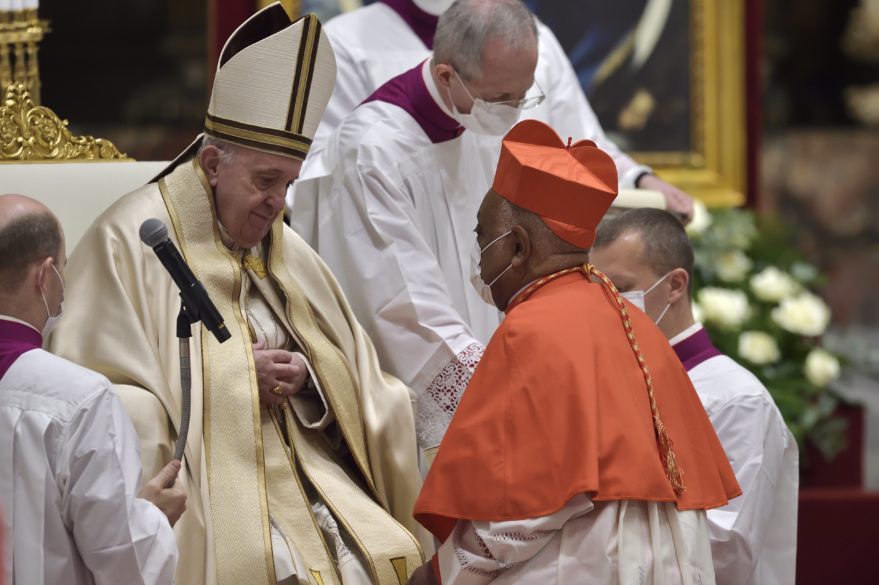By Cindy Wooden
VATICAN CITY (CNS) – One by one 11 senior churchmen, including two U.S. citizens – Cardinals Wilton D. Gregory of Washington and Silvano M. Tomasi, a former Vatican diplomat – knelt before Pope Francis to receive their red hats, a cardinal’s ring and a scroll formally declaring their new status and assigning them a “titular” church in Rome.
But with the consistory Nov. 28 occurring during the COVID-19 pandemic, Pope Francis actually created 13 new cardinals.
Cardinals Jose F. Advincula of Capiz, Philippines, and Cornelius Sim, apostolic vicar of Brunei, did not attend the consistory because of COVID-19 travel restrictions; however, they are officially cardinals and will receive their birettas and rings at a later date, the Vatican said.
In his homily at the prayer service, Pope Francis told the new cardinals that “the scarlet of a cardinal’s robes, which is the color of blood, can, for a worldly spirit, become the color of a secular ’eminence,'” the traditional title of respect for a cardinal.
If that happens, he said, “you will no longer be a pastor close to your people. You will think of yourself only as ‘His Eminence.’ If you feel that, you are off the path.”
For the cardinals, the pope said, the red must symbolize a wholehearted following of Jesus, who willingly gave his life on the cross to save humanity.
According to canon law, cardinals are created when their names are made public “in the presence of the College of Cardinals.” While many Rome-based cardinals attended the consistory, more members of the college were “present” online.

The pandemic also meant the gathering was unusually small; each cardinal was accompanied by a priest-secretary and could invite a handful of guests, so there were only about 100 people in the congregation at the Altar of the Chair in St. Peter’s Basilica.
The new cardinals came from eight countries: Italy, Malta, the United States, Brunei, the Philippines, Mexico, Rwanda and Chile.
Cardinal Gregory, like the other new cardinals coming from outside Europe, was tested for COVID-19 before flying to Rome and again upon arrival. Even after testing negative, he and the others were required to quarantine for 10 days and were tested again immediately before the consistory.
In an interview with Catholic News Service, the cardinal said he hopes Pope Francis will find him to be “supportive, encouraging and trustworthy” in his role as a cardinal, but his primary ministry is still to be the archbishop of Washington.
Of course, he said, he regrets that “my two sisters are not here, and the many people I know and love from Chicago and Belleville (Illinois) and Atlanta and Washington,” who were watching the livestream instead.
One of Cardinal Tomasi’s guests was the pastor of his boyhood parish, San Rocco in Casoni di Mussolente, a town of fewer than 8,000 people in northern Italy. In the past 80 years, the cardinal told CNS, the parish has produced more than 100 priests and religious sisters, “and now also a cardinal. I hope it will help to continue the flourishing of vocations from the parish.”
With the consistory the College of Cardinals now has 229 members, 128 of whom are under the age of 80 and eligible to enter a conclave to elect a new pope. Pope Francis has given the red hat to 57% of electors.
With Cardinals Gregory and Tomasi, who was born in Italy but is a U.S. citizen, the number of U.S. cardinals rose to 16; nine of them are cardinal electors.
